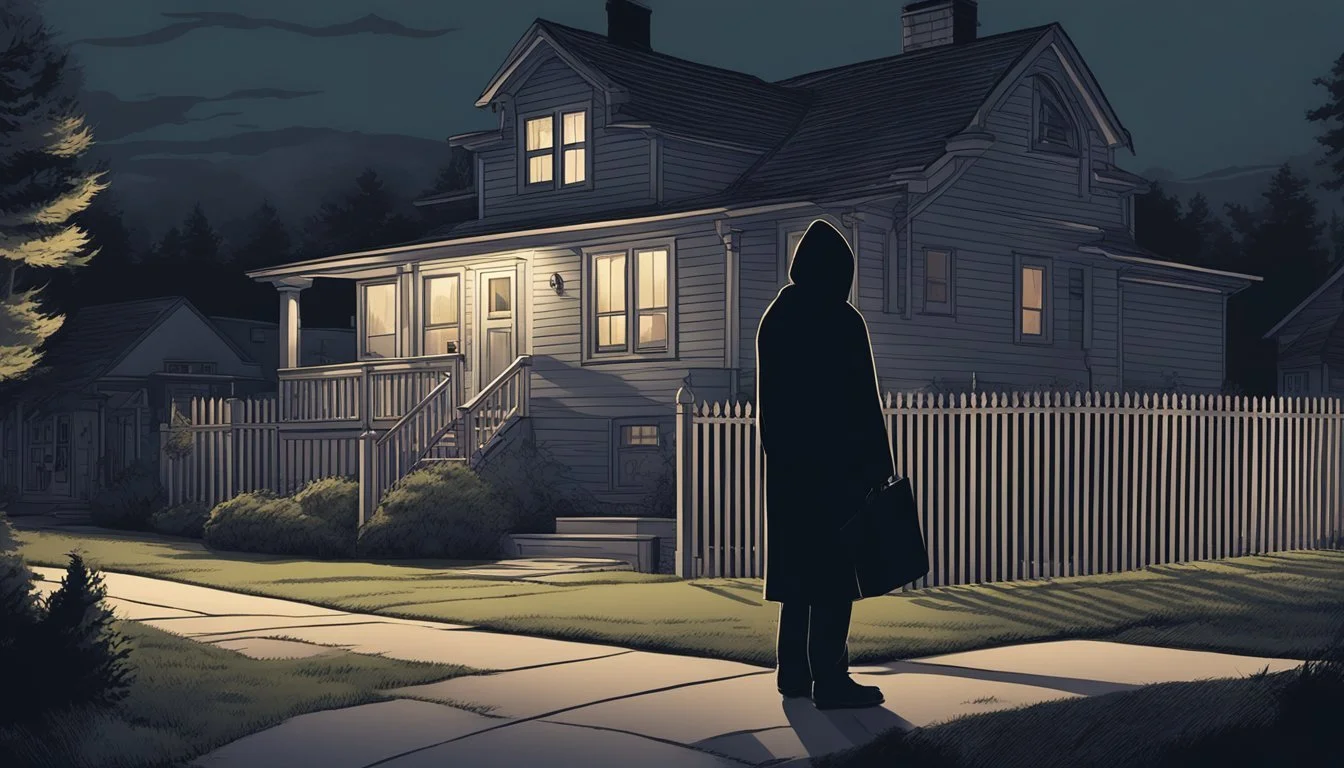Unmasking the Mystery: Who Killed JonBenet Ramsey Case? Shocking New Evidence Could Change Everything!
The unsolved murder of JonBenét Ramsey continues to captivate public interest decades after the tragic event. On December 26, 1996, the six-year-old beauty queen was found dead in the basement of her family's home in Boulder, Colorado. Despite extensive investigations, the case remains open, and the identity of JonBenét's killer has never been definitively determined.
The investigation has explored numerous suspects over the years, including family members, household staff, and even a man who falsely confessed to the crime. Evidence at the scene included a ransom note, signs of sexual assault, and a fractured skull. DNA analysis has provided some leads, but has not yet led to a conclusive identification of the perpetrator.
The case has been marked by controversy, with criticism directed at the initial handling of the crime scene and subsequent investigative efforts. Recent developments include the formation of a Colorado Cold Case Team, which is reexamining key evidence in hopes of finally solving the mystery that has haunted the nation for nearly three decades.
Background of the Case
The JonBenét Ramsey case shocked America in December 1996. A young beauty queen was found dead in her family's home, sparking a complex investigation that remains unsolved to this day.
JonBenét's Profile
JonBenét Patricia Ramsey was born on August 6, 1990, in Atlanta, Georgia. At just six years old, she had already made a name for herself in child beauty pageants. With her blonde hair and bright smile, JonBenét won numerous titles, including Little Miss Colorado.
She lived with her family in Boulder, Colorado. JonBenét attended kindergarten at High Peaks Elementary School. Despite her pageant success, friends described her as a normal, playful child who enjoyed riding her bike and playing with her brother.
Ramsey Family
The Ramsey family consisted of father John, mother Patsy, and children Burke and JonBenét. John Ramsey was a successful businessman, president of Access Graphics, a computer services company. Patsy, a former Miss West Virginia, was actively involved in her daughter's pageant career.
The family had moved from Atlanta to Boulder in 1991 for John's work. They lived in a large, 15-room house in an affluent neighborhood. The Ramseys were well-known in Boulder's social circles and active in the local community.
Prior to the tragedy, the family appeared to lead a charmed life. They were financially comfortable and often hosted parties at their home.
Day of the Discovery
On December 26, 1996, Patsy Ramsey called 911 at 5:52 AM, reporting that her daughter was missing. She told police she had found a ransom note demanding $118,000 for JonBenét's safe return.
Police arrived and searched the house but found no signs of forced entry. Friends and family gathered at the home throughout the day. At around 1:00 PM, Detective Linda Arndt suggested John Ramsey search the house again.
John and his friend Fleet White went to the basement. There, John discovered JonBenét's body in a little-used room. She had been strangled with a garrote and suffered a skull fracture.
The discovery turned a kidnapping case into a homicide investigation. Boulder police faced criticism for their handling of the crime scene in the crucial early hours.
Initial Response and Evidence
The initial hours following the discovery of JonBenét Ramsey's disappearance were critical. Law enforcement's response, examination of key evidence, and observations at the crime scene shaped the course of the investigation.
First Response by Boulder Police
Boulder Police Department officers arrived at the Ramsey home on December 26, 1996, at approximately 5:55 AM. They responded to Patsy Ramsey's 911 call reporting her daughter missing. Officers conducted an initial search of the house but did not secure it as a crime scene.
This decision later faced criticism as it allowed potential contamination of evidence. Friends and family were permitted to move freely throughout the home. The police did not immediately recognize the gravity of the situation, initially treating it as a potential kidnapping rather than a homicide.
Examining the Ransom Note
A key piece of evidence was the ransom note found by Patsy Ramsey on the kitchen stairs. At 2.5 pages long, it was unusually detailed for a ransom note. The note demanded $118,000 for JonBenét's safe return - coincidentally close to John Ramsey's recent bonus amount.
Police collected the note for handwriting analysis and fingerprinting. Experts later determined the note was written using paper and a pen from the Ramsey home. This raised questions about whether an intruder would have had time to compose such a lengthy note at the scene.
Crime Scene Observations
JonBenét's body was discovered in the wine cellar of the Ramsey home at approximately 1:05 PM by her father, John Ramsey. The crime scene revealed several important details:
A nylon cord around JonBenét's neck
Duct tape over her mouth
Signs of sexual assault
A fractured skull
Investigators noted the lack of obvious signs of forced entry. This, combined with the ransom note's origins, led to early suspicion of the family. However, unidentified DNA was later found on JonBenét's clothing, complicating the investigation.
Key Developments in the Investigation
The JonBenét Ramsey case has seen several significant developments since 1996. These include evolving suspect theories, advancements in DNA analysis, and the emergence of the intruder theory.
Early Suspect Theories
Initial investigations focused on JonBenét's family members. The Boulder Police Department considered the parents, John and Patsy Ramsey, as prime suspects. This led to intense scrutiny and public speculation about their involvement.
Burke Ramsey, JonBenét's brother, was also questioned. Some theories suggested he might have been responsible, though he was only 9 years old at the time.
Local sex offenders and known pedophiles in the area were investigated. However, these early inquiries failed to produce conclusive evidence or lead to an arrest.
DNA Evidence and Its Impact
DNA analysis has played a crucial role in the investigation. In 2003, male DNA was found on JonBenét's clothing that did not match any family members.
This discovery led the Boulder District Attorney's office to formally clear the Ramsey family of suspicion in 2008. The DNA profile was entered into the FBI's national database but has not yet matched any known offender.
Recent advancements in DNA technology have renewed hope for solving the case. Investigators are exploring the use of genetic genealogy, which has helped solve other cold cases.
The Intruder Theory
Lou Smit, a detective brought out of retirement to assist with the case, developed the intruder theory. He believed an outsider broke into the Ramsey home and committed the crime.
Smit pointed to evidence such as a basement window that appeared to be forced open and unidentified footprints found at the scene. He also noted the complexity of the crime scene, which he felt was inconsistent with a family cover-up.
The intruder theory gained traction among some investigators and members of the public. It remains a significant alternative to the family-involvement theories that initially dominated the investigation.
Challenges and Controversies
The JonBenét Ramsey case faced numerous obstacles and sparked intense debates. Key issues included conflicts between law enforcement agencies, media influence, and public scrutiny.
Boulder Police vs. District Attorney
The Boulder Police Department and District Attorney's office clashed over the investigation's direction. Police initially focused on the Ramsey family as suspects, while the DA's office explored other possibilities. This tension led to communication breakdowns and hindered progress.
The police criticized the DA for not filing charges against the Ramseys. The DA argued there was insufficient evidence for prosecution. This divide created confusion and slowed the case.
Media Influence on the Case
Media coverage heavily impacted the JonBenét Ramsey investigation. National news programs like "Good Morning America," "20/20," and "48 Hours" extensively covered the case. This attention put pressure on investigators and shaped public perception.
Tabloids published sensational stories, often based on unverified information. These reports sometimes interfered with the official investigation by spreading misinformation.
The media spotlight also affected witness cooperation. Some potential informants hesitated to come forward due to privacy concerns.
Public and Legal Scrutiny
The case generated intense public interest and debate. Many armchair detectives formed strong opinions about who was responsible for JonBenét's death. This public scrutiny sometimes led to harassment of individuals connected to the case.
Legal experts criticized aspects of the investigation, including:
Contamination of the crime scene
Delayed interviewing of key witnesses
Premature elimination of suspects
These issues complicated efforts to build a solid case against any suspect. They also fueled ongoing speculation about the true perpetrator.
Theories and Suspects
The JonBenét Ramsey case has generated numerous theories and suspects over the years. Investigators have explored potential family involvement, outside intruders, and various individuals with possible motives.
Burke Ramsey
Burke Ramsey, JonBenét's older brother, has faced scrutiny in the case. Some theorists point to his behavior after the murder and potential sibling rivalry. Critics argue that a 9-year-old would lack the strength for such an attack.
Supporters of this theory cite undigested pineapple found in JonBenét's stomach, which matched a bowl in the kitchen. Burke's fingerprints were on the bowl. However, no conclusive evidence has linked Burke to the crime.
Alternate Suspects
Several other individuals have been investigated as potential suspects. Michael Helgoth, a local mechanic, became a person of interest but died by suicide in 1997. Investigators later ruled him out.
Bill McReynolds, who played Santa Claus at the Ramsey home, drew attention due to a past connection to a child's disappearance. Gary Oliva, a convicted pedophile, has also been scrutinized. Neither has been formally charged.
John Ramsey, JonBenét's father, faced suspicion early in the investigation. However, DNA evidence has since excluded immediate family members as suspects.
Profile of Potential Perpetrators
Experts have developed profiles of possible perpetrators based on crime scene evidence. These profiles often suggest an adult male with knowledge of the Ramsey home.
Key elements include familiarity with the house layout, possible prior contact with JonBenét, and experience with knot-tying. The perpetrator likely had a history of child abuse or sexual assault.
Some theories propose multiple individuals were involved, complicating the investigation. The mix of evidence suggesting both an intruder and someone familiar with the family continues to puzzle investigators.
Scientific Advances and Case Re-Evaluation
Technological breakthroughs and renewed investigative efforts have breathed new life into the JonBenét Ramsey case. Advanced forensic techniques offer fresh perspectives on long-standing evidence, potentially uncovering crucial details that were previously overlooked.
Revisiting DNA Testing
DNA evidence remains a critical focus in the JonBenét Ramsey investigation. Recent advancements in DNA technology have allowed for more sensitive and precise analysis of genetic material. Investigators have reexamined trace DNA samples found on JonBenét's clothing and under her fingernails.
These new tests can detect and analyze much smaller amounts of DNA than was possible in the 1990s. They also allow for the separation of mixed DNA profiles, which could be crucial in identifying potential suspects.
Law enforcement agencies are now exploring the use of genetic genealogy databases to cross-reference DNA profiles from the crime scene. This technique has successfully solved other cold cases and may provide new leads in the Ramsey investigation.
Forensic Pathology Insights
Modern forensic pathology techniques have shed new light on JonBenét's autopsy findings. Experts have reevaluated the original autopsy report using current knowledge and methodologies.
Advanced imaging technologies now allow for more detailed analysis of injuries and wound patterns. This has led to refined timelines of events and a better understanding of the sequence of injuries inflicted on JonBenét.
Forensic pathologists have also reexamined trace evidence from the crime scene using electron microscopy and spectral analysis. These methods can reveal microscopic details about fibers, hair, and other materials that may have been missed in earlier examinations.
Technology and Cold Case Analysis
Artificial intelligence and machine learning algorithms are revolutionizing cold case analysis. These tools can process vast amounts of case data, identifying patterns and connections that human investigators might miss.
In the Ramsey case, AI-powered software has been used to analyze:
Witness statements
Police reports
Crime scene photographs
Physical evidence records
This technology helps prioritize leads and generate new investigative angles. It can also assist in creating more accurate suspect profiles based on behavioral patterns and forensic evidence.
3D crime scene reconstruction technology now allows investigators to virtually revisit the Ramsey home. This immersive approach helps visualize evidence placement and test various theories about the crime's execution.
Societal Impact and Legacy
The JonBenét Ramsey case profoundly shaped American society, leaving an enduring mark on child beauty pageants, popular culture, and law enforcement practices. Its influence extended far beyond the tragic events of December 1996.
Impact on Child Beauty Pageants
The murder of JonBenét Ramsey cast a dark shadow over child beauty pageants. Public scrutiny intensified, raising concerns about the sexualization of young girls and potential exploitation. Many pageant organizers implemented stricter safety measures and age restrictions. Participation rates declined as parents grew wary of the spotlight.
Some states considered banning child beauty pageants altogether. The controversy sparked debates about child welfare and appropriate activities for minors. Pageant culture shifted, with a greater emphasis on talent and academic achievement rather than appearance alone.
Influence on Popular Culture
The case became a media sensation, dominating headlines for years. True crime podcasts, documentaries, and TV specials continue to examine the unsolved murder. Books, both fiction and non-fiction, draw inspiration from the case.
The tragedy entered the zeitgeist, referenced in songs, movies, and TV shows. It became shorthand for unsolved mysteries and media frenzies. The image of JonBenét in her pageant attire became iconic, symbolizing lost innocence.
ABC News and other major networks produced numerous specials on the case. The story's longevity in popular culture reflects society's fascination with true crime and unsolved mysteries.
Long-Term Effects on Law Enforcement
The JonBenét Ramsey case exposed flaws in investigative procedures, prompting changes in law enforcement practices. Police departments nationwide improved evidence collection techniques and crime scene preservation protocols.
Inter-agency cooperation became a priority, addressing issues that hindered the initial investigation. Training programs for detectives handling high-profile cases were developed. The case underscored the importance of proper media relations during major investigations.
DNA technology advancements were partly driven by efforts to solve this case. Law enforcement agencies invested in cutting-edge forensic tools, hoping to crack cold cases like JonBenét's murder.
Current Status and Summary
The JonBenét Ramsey case remains unsolved after nearly three decades. Recent developments have brought renewed attention and hope for a breakthrough in identifying her killer.
Where the Case Stands Today
The Boulder County District Attorney's office continues to investigate the 1996 murder of JonBenét Ramsey. In 2025, the Colorado Cold Case Team has reexamined crucial evidence, sparking fresh interest in the case.
DNA technology advancements have allowed investigators to analyze almost 1,000 DNA samples in their quest to find the killer. This renewed effort has given JonBenét's father, John Ramsey, renewed hope for resolution.
Progress is reportedly being made, according to sources close to the investigation. The case has seen a surge in public interest, putting pressure on authorities to solve this long-standing mystery.
Summary of Evidence and Findings
Key evidence in the JonBenét Ramsey case includes:
DNA samples from the crime scene
The ransom note found in the Ramsey home
Autopsy results detailing the cause of death
Physical evidence from the basement where JonBenét's body was discovered
Investigators have faced challenges due to contamination of the crime scene and conflicting theories about the killer's identity. A grand jury found probable cause to indict JonBenét's parents in 1999, but the district attorney declined to file charges.
Recent forensic analysis and witness interviews have provided new leads. The Cold Case Team is focusing on previously overlooked details that may finally bring closure to this tragic unsolved murder.




